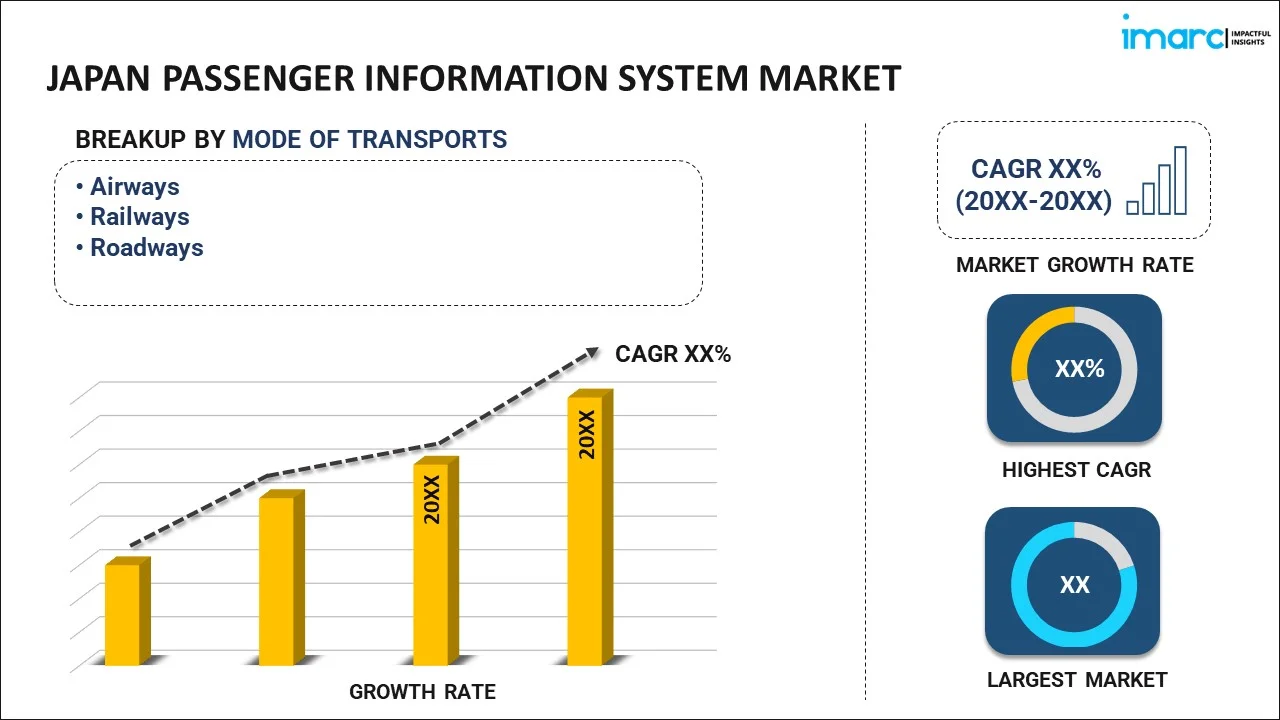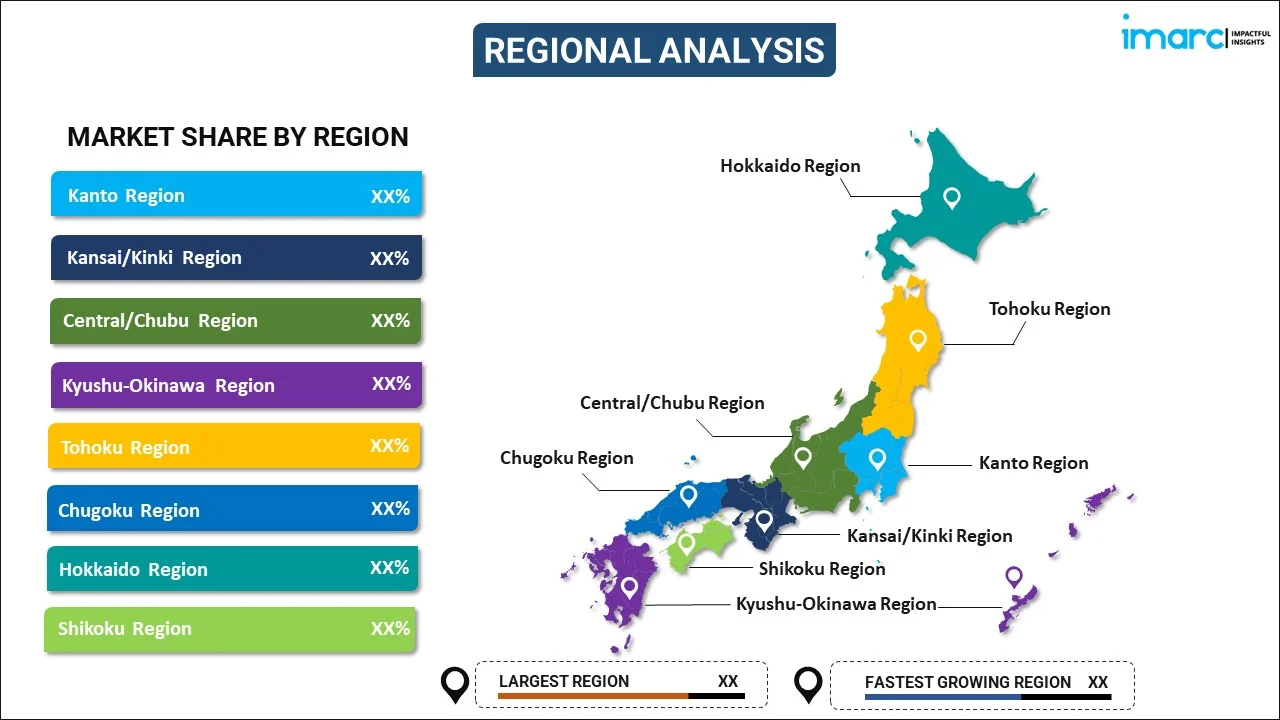
Japan Passenger Information System Market Report by Mode of Transport (Airways, Railways, Roadways), Component (Hardware and Software, Services), Location (On Board, In Station), System Type (Multimedia Displays, Audio Systems, Computing Systems, Networking and Communication Devices, Video Surveillance Systems, Content Management System, and Others), and Region 2025-2033
Market Overview:
Japan passenger information system market size reached USD 1.5 Billion in 2024. Looking forward, IMARC Group expects the market to reach USD 3.4 Billion by 2033, exhibiting a growth rate (CAGR) of 8.4% during 2025-2033. The increasing advancements in technology, such as the availability of high-speed internet, mobile apps, GPS, and data analytics, which have enabled more sophisticated and real-time passenger information system solutions, are driving the market.
|
Report Attribute
|
Key Statistics
|
|---|---|
|
Base Year
|
2024
|
|
Forecast Years
|
2025-2033
|
|
Historical Years
|
2019-2024
|
|
Market Size in 2024
|
USD 1.5 Billion |
|
Market Forecast in 2033
|
USD 3.4 Billion |
| Market Growth Rate 2025-2033 | 8.4% |
A passenger information system (PIS) is a critical component of modern public transportation systems. It is designed to enhance the overall travel experience for passengers by providing real-time information about routes, schedules, and various aspects of their journey. Typically, PIS includes digital displays, announcements, and mobile apps that deliver information such as estimated arrival times, service disruptions, and connecting transportation options. PIS serves several important purposes. It helps passengers make informed decisions about their travel plans, reducing uncertainty and stress. It also contributes to the efficient operation of public transportation networks by distributing information to passengers and minimizing congestion caused by confusion or delays. Additionally, PIS can improve safety by conveying emergency alerts and security information. In recent years, advancements in technology have allowed for more sophisticated PIS solutions, including GPS tracking, integration with payment systems, and personalized trip planning. These innovations continue to make public transportation more user-friendly and accessible, ultimately promoting the use of sustainable transportation options.
Japan Passenger Information System Market Trends:
The passenger information system market in Japan is witnessing robust growth due to several interconnected factors. Firstly, the increasing urbanization has led to a surge in public transportation systems, creating a higher demand for PIS solutions. Consequently, this has prompted governments and transportation authorities to invest in advanced PIS to enhance the overall commuter experience. Furthermore, the rising awareness of the importance of real-time information among passengers is propelling market growth. With the advent of smartphones and mobile apps, travelers now expect up-to-the-minute updates on routes, delays, and schedules. Consequently, PIS providers are compelled to innovate and integrate their systems with digital platforms, further driving market expansion. Moreover, the need for efficient transportation services in congested urban areas is pushing transportation providers to adopt PIS solutions. The ability to optimize routes, manage traffic flow, and reduce congestion is a compelling driver for PIS adoption. In addition to this, the growing focus on sustainability and environmental concerns, which is encouraging the adoption of PIS to provide real-time data on the availability of public transportation, thereby reducing the number of private vehicles and contributing to a greener ecosystem, is expected to drive the passenger information system market in Japan.
Japan Passenger Information System Market Segmentation:
IMARC Group provides an analysis of the key trends in each segment of the market, along with forecasts at the country level for 2025-2033. Our report has categorized the market based on mode of transport, component, location, and system type.
Mode of Transport Insights:

- Airways
- Railways
- Roadways
The report has provided a detailed breakup and analysis of the market based on the mode of transport. This includes airways, railways, and roadways.
Component Insights:
- Hardware and Software
- Services
A detailed breakup and analysis of the market based on the component have also been provided in the report. This includes hardware and software and services.
Location Insights:
- On Board
- In Station
The report has provided a detailed breakup and analysis of the market based on the location. This includes on board and in station.
System Type Insights:
- Multimedia Displays
- Audio Systems
- Computing Systems
- Networking and Communication Devices
- Video Surveillance Systems
- Content Management System
- Others
A detailed breakup and analysis of the market based on the system type have also been provided in the report. This includes multimedia displays, audio systems, computing systems, networking and communication devices, video surveillance systems, content management system, and others.
Regional Insights:

- Kanto Region
- Kansai/Kinki Region
- Central/ Chubu Region
- Kyushu-Okinawa Region
- Tohoku Region
- Chugoku Region
- Hokkaido Region
- Shikoku Region
The report has also provided a comprehensive analysis of all the major regional markets, which include Kanto Region, Kansai/Kinki Region, Central/ Chubu Region, Kyushu-Okinawa Region, Tohoku Region, Chugoku Region, Hokkaido Region, and Shikoku Region.
Competitive Landscape:
The market research report has also provided a comprehensive analysis of the competitive landscape. Competitive analysis such as market structure, key player positioning, top winning strategies, competitive dashboard, and company evaluation quadrant has been covered in the report. Also, detailed profiles of all major companies have been provided.
Japan Passenger Information System Market Report Coverage:
| Report Features | Details |
|---|---|
| Base Year of the Analysis | 2024 |
| Historical Period | 2019-2024 |
| Forecast Period | 2025-2033 |
| Units | Billion USD |
| Scope of the Report | Exploration of Historical and Forecast Trends, Industry Catalysts and Challenges, Segment-Wise Historical and Predictive Market Assessment:
|
| Mode of Transports Covered | Airways, Railways, Roadways |
| Components Covered | Hardware and Software, Services |
| Locations Covered | On Board, In Station |
| System Types Covered | Multimedia Displays, Audio Systems, Computing Systems, Networking and Communication Devices, Video Surveillance Systems, Content Management System, Others |
| Regions Covered | Kanto Region, Kansai/Kinki Region, Central/ Chubu Region, Kyushu-Okinawa Region, Tohoku Region, Chugoku Region, Hokkaido Region, Shikoku Region |
| Customization Scope | 10% Free Customization |
| Post-Sale Analyst Support | 10-12 Weeks |
| Delivery Format | PDF and Excel through Email (We can also provide the editable version of the report in PPT/Word format on special request) |
Key Questions Answered in This Report:
- How has the Japan passenger information system market performed so far and how will it perform in the coming years?
- What has been the impact of COVID-19 on the Japan passenger information system market?
- What is the breakup of the Japan passenger information system market on the basis of mode of transport?
- What is the breakup of the Japan passenger information system market on the basis of component?
- What is the breakup of the Japan passenger information system market on the basis of location?
- What is the breakup of the Japan passenger information system market on the basis of system type?
- What are the various stages in the value chain of the Japan passenger information system market?
- What are the key driving factors and challenges in the Japan passenger information system?
- What is the structure of the Japan passenger information system market and who are the key players?
- What is the degree of competition in the Japan passenger information system market?
Key Benefits for Stakeholders:
- IMARC’s industry report offers a comprehensive quantitative analysis of various market segments, historical and current market trends, market forecasts, and dynamics of the Japan passenger information system market from 2019-2033.
- The research report provides the latest information on the market drivers, challenges, and opportunities in the Japan passenger information system market.
- Porter's five forces analysis assist stakeholders in assessing the impact of new entrants, competitive rivalry, supplier power, buyer power, and the threat of substitution. It helps stakeholders to analyze the level of competition within the Japan passenger information system industry and its attractiveness.
- Competitive landscape allows stakeholders to understand their competitive environment and provides an insight into the current positions of key players in the market.
Need more help?
- Speak to our experienced analysts for insights on the current market scenarios.
- Include additional segments and countries to customize the report as per your requirement.
- Gain an unparalleled competitive advantage in your domain by understanding how to utilize the report and positively impacting your operations and revenue.
- For further assistance, please connect with our analysts.
 Request Customization
Request Customization
 Speak to an Analyst
Speak to an Analyst
 Request Brochure
Request Brochure
 Inquire Before Buying
Inquire Before Buying




.webp)




.webp)












